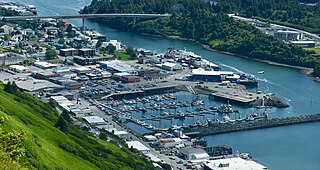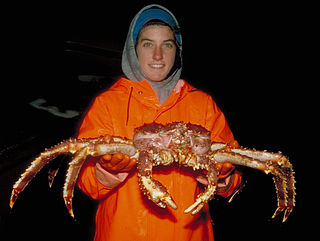Unga or UNGA may refer to:
Unga or UNGA may refer to:

The Bering Sea is a marginal sea of the Northern Pacific Ocean. It forms, along with the Bering Strait, the divide between the two largest landmasses on Earth: Eurasia and the Americas. It comprises a deep water basin, which then rises through a narrow slope into the shallower water above the continental shelves. The Bering Sea is named after Vitus Bering, a Danish navigator in Russian service, who, in 1728, was the first European to systematically explore it, sailing from the Pacific Ocean northward to the Arctic Ocean.

The City of Kodiak is the main city and one of seven communities on Kodiak Island in Kodiak Island Borough, Alaska. All commercial transportation between the island's communities and the outside world goes through this city via ferryboat or airline. As of the 2020 census, the population of the city is 5,581, down from 6,130 in 2010. It is the tenth-largest city in Alaska.

Roe, or hard roe, is the fully ripe internal egg masses in the ovaries, or the released external egg masses, of fish and certain marine animals such as shrimp, scallop, sea urchins and squid. As a seafood, roe is used both as a cooked ingredient in many dishes, and as a raw ingredient for delicacies such as caviar.

The Gulf of Alaska is an arm of the Pacific Ocean defined by the curve of the southern coast of Alaska, stretching from the Alaska Peninsula and Kodiak Island in the west to the Alexander Archipelago in the east, where Glacier Bay and the Inside Passage are found.
Kani may refer to:

The Dungeness crab makes up one of the most important seafood industries along the west coast of North America. Its typical range extends from Alaska's Aleutian Islands to Point Conception, near Santa Barbara, California. Dungeness typically grow 6-7 inches at their widest point and inhabit eelgrass beds and sandy bottoms. Its common name comes from the Dungeness Spit in the Strait of Juan de Fuca, Washington state, United States, which shelters a shallow bay inhabited by the crabs.
Flagstaff Hill usually refers to a hill on which a flag was erected. It may refer to:

Deadliest Catch is an American reality television series that premiered on the Discovery Channel on April 12, 2005. The show follows crab fishermen aboard fishing vessels in the Bering Sea during the Alaskan king crab and snow crab fishing seasons. The base of operations for the fishing fleet is the Aleutian Islands port of Dutch Harbor, Alaska. Produced for the Discovery Channel, the show's title is derived from the inherent high risk of injury or death associated with this line of work.

Alaskan king crab fishing is carried out during the fall in the waters off the coast of Alaska and the Aleutian Islands. The commercial catch is shipped worldwide. Large numbers of king crab are also caught in Russian and international waters.
Fish River may refer to:

Unga Island is the largest of the Shumagin Islands off the Alaska Peninsula in southwestern Alaska, United States. The island has a land area of 170.73 sq mi (442.188 km2), making it the 36th largest island in the United States. As of the 2000 census, it had a permanent population of one.

Chionoecetes bairdi is a species of snow crab, alternatively known as bairdi crab and tanner crab. C. bairdi is closely related to Chionoecetes opilio, and it can be difficult to distinguish C. opilio from C. bairdi. Both species are found in the Bering Sea and are sold commercially under the name "snow crab." Tanner crabs have suffered from overfishing and as a result strict controls have been placed on tanner crab fisheries. It was named by Mary Jane Rathbun, a Smithsonian employee who became one of the leading authorities on crab taxonomy. She named the crab for Spencer Baird, her mentor, who in the 1880s as Secretary of the Smithsonian Institution and head of the United States Fish Commission, had given her her first position.

Crab meat or crab marrow is the meat found within a crab, or more specifically in the leg of a crab. It is used in many cuisines around the world for its soft, delicate and sweet flavor. Crab meat is low in fat and provides approximately 340 kilojoules (82 kcal) of food energy per 85-gram (3 oz) serving. Brown crab, blue crabs, blue swimming crabs, and red swimming crabs are among the most commercially available species of crabmeat globally.

Unga is a ghost town on Unga Island in the Aleutians East Borough of the U.S. state of Alaska, about two miles west of Sand Point. The island's length is 15 miles (24 km). Unga's altitude is 59 feet (18 m).
Ounga may refer to:

Paralithodes platypus, the blue king crab, is a species of king crab from cold waters in the North Pacific Ocean and adjacent seas. Although blue king crabs are among the largest crabs in the world and reputedly may exceed 18 pounds (8.2 kg) in weight, they are generally smaller than red king crabs.
Fritz Cove is a bay on the northwestern coast of Douglas Island in the City and Borough of Juneau, Alaska, United States. Lying in Stephens Passage, it is 8 miles (13 km) northwest of the city of Juneau.
Declawing of crabs is the process whereby one or both claws of a crab are manually detached before the return of the live crab to the water, as practiced in the fishing industry worldwide. Crabs commonly have the ability to regenerate lost limbs after a period of time, and thus declawing is viewed as a potentially more sustainable method of fishing. Due to the time it takes for a crab to regrow lost limbs, however, whether or not the practice represents truly sustainable fishing is still a point of scientific inquiry, and the ethics of declawing are also subject to debates over pain in crustaceans.

Crab sticks, krab sticks, snow legs, imitation crab (meat), or seafood sticks are a type of seafood made of starch and finely pulverized white fish (surimi) that has been shaped and cured to resemble the leg meat of snow crab or Japanese spider crab. It is a product that uses fish meat to imitate shellfish meat.

Surimi is a paste made from fish or other meat. The term can also refer to a number of East Asian foods that use that paste as their primary ingredient. It is available in many shapes, forms, and textures, and is often used to mimic the texture and color of the meat of lobster, crab, grilled Japanese eel or shellfish.